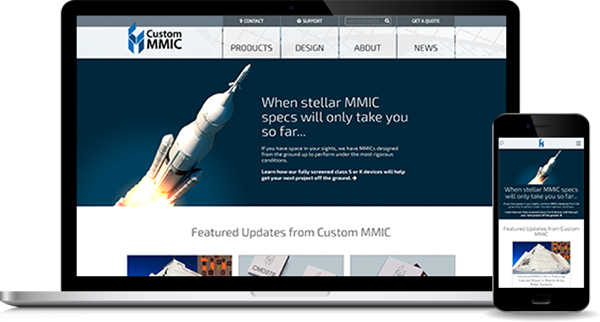The Best Approach to Designing a New B-to-B Product Website and Platform for Digital Content Marketing Success
By David Strand, CEO/Brand Director

There’s obvious benefit to anyone who’s chosen to make a marketing career in any given business niche. In addition to building the best business relationships and friendships, years of observation allow you to witness the repetitive patterns of the prospect. As the patterns become predictable, you can leverage that insight to build creative and efficient sales lead generation systems. I started as an in-house marketing manager for Adams-Russell, then moved to MACOM, and have now built my own demand generation agency over the last 20+ years. I’ve operated successfully through the age of traditional print advertising, direct mail, PR, catalog publishing, and tradeshows and have been enjoying every minute of the fast-paced, and more scientific, digital age of B-to-B technology and industrial marketing and advertising we’re in today.
If there’s one thing that’s always been a constant for me, it’s that the critical hour for a marketer is the moment an engineering prospect is evaluating components for his or her latest system block diagram. Prospects will either visit your website, or they won’t, and if they do, how you present your brand and your data matters.
On a good day, your engineering prospect will view 3-4 pages of your website and spend 2-3 minutes on your site. They’ll download a piece of content and agree to getting your email updates, and they’ll send a request for pricing on a key component in their system. On a bad day, they’ll bounce off your home page (or whatever page they’ve arrived on), in under 5 seconds because they simply don’t deem your site worthy of their time. Worse still, they never find you. The amount of good days vs. bad days is at the very core of any successful tech company’s growth strategy today, and here’s how you can you ensure the balance is in your favor vs. your competition.
Take a foundational, intention-based marketing approach
There are a litany of books and blogs on B2B marketing, many of them published by SaaS software companies specializing in Inbound Marketing, Marketing Automation, Customer Relationship Management (CRM), and Content Management Systems (CMS). While insightful to a degree, the common problem with this information is that, by nature, the authors of this content speak in terms of best-case, enterprise-level solutions. They also assume a high level of adoption of SaaS marketing solutions by their audience. They spend time trying to sway you away from your current SaaS providers by providing comparison tables and case studies that cover their most advanced features that are rarely the core module you need. A common challenge for many small to mid-size tech companies is that their marketing foundation has not changed dramatically in the last few years with the times, and a new one has yet to be strategized.
For these companies, the foundation today starts with a database-driven, mobile responsive website with a customized CMS and integrated marketing automation and CRM. An example is a site Strand built for Custom MMIC which was architected and developed using Strand’s proprietary platform, Intent ICMS™. In the backend is a MySQL database of Custom MMIC’s entire catalog of MMIC devices complete with a field for every piece of relational data from frequency band to life cycle to package type. Also included are photos, features and applications, related S-parameter data and application notes, and, of course, a data sheet for each model.
By default, Intent ICMS allows our team to practice the most up-to-date SEO fundamentals with every page that gets published. (While there are notable gurus in the field, we believe in following Google’s advice when it comes to SEO). This means that an SEO foundation is built in-site during production of a new site or new pages, as opposed to applying SEO tactics after publishing to the web. URLs, headlines, and copy are carefully crafted, photos tagged, meta descriptions attached, links embedded, page load speeds optimized… and everything else Google suggests as “SEO 101” is completed before any advanced techniques are deployed. These are the best foundational back-end elements I can recommend for any tech or industrial manufacturer's website.
Did You Know?
PDFs are often the most highly ranked search result. The reason is they are completely searchable by search engine robots and are keyword rich. You can help your overall organic search rankings tremendously by naming your data sheet files in a more search engine friendly way, as opposed to what your document control system automatically creates. When that’s impossible, you should at least name the title link to it with SEO in mind. This will also help them get more easily recognized. Do both and watch your data sheets perform for you like never before.
Over-complicated product navigation and parametric searches will send engineers looking elsewhere
Focusing on your website’s front-end user experience now, an absolute must is to be mindful of your prospect’s time and their most likely intention for visiting your site—a product solution. Remember, you’ve got about 3 pages and 3 minutes to engage them. Complicated and costly parametric searches that were once the mighty achievements of engineers, coders, and marketers, are often outwitted by an engineering-driven prospect today, resulting in failure to display a result, or a display of half your catalog. These undesirable results are common culprits of bounces. Another culprit is assuming that your prospects will enjoy the opportunity to evaluate your products down several different top-level navigation paths from function, to features, to technology type, to applications. They don’t. Whether engineers are involved in military system design or automotive electronics, they are looking for one thing—an amplifier, a switch, or any number of other components that operate in their frequency or other key specification. Make your main product navigation singular and clear and based on core product functions. List your basic product categories by industry term (not your branded model names) and drop prospects on category overview pages with tables that are then easy to sort and filter on, while offering a chance to down-select to a few models to conduct a side-by-side comparison. If your budget allows, build out a model detail landing page with 50-100% of the data from page one of each model’s datasheet. It’s not only a great user experience, you’ve just added another page of content on the world wide web for every model in your catalog!
If your budget doesn’t allow for this full build out today, customize your CMS in stages and provide the datasheet behind a click on the model number in the product category table as a phase 1.
With the main reason for your prospect’s visit foundationally addressed by a solid, customized CMS, you can now focus on the next thing that will both attract them to and keep them on your site—knowledge. With a suite of 4-6 page Tech Briefs and complementary blogs, you will not only demonstrate your brand’s thought-leadership, you can convincingly suggest that a prospect should provide an email address to download their first piece of content and keep receiving your insights and new products routinely.
Cranking up your digital marketing machine
With your marketing nucleus firmly established in the form of new content, and an SEO-rich website, you can now begin actively driving prospects to them both with a thoughtful, intention-based content marketing (or digital marketing) strategy.
As print is by no means dead, start by creating your brand position in the form of a full-page ad. In addition to using it to gain eyeballs in key industry magazines during lunch and coffee breaks—and thereby maintaining an 8 X 10 presence among your industry peers each month—you can use the creative concept to cement your brand position on your home page in the “hero position”. This spot is often occupied by several rotating messages in a carousel, but the trend today is to stop the madness of these rotating messages and take the moment to nail your core brand position in the market visit-after-visit. As page scrolling is more acceptable today, you can pepper your home page and interior pages with various featured content strategically placed via your CMS throughout your site as Calls-to-Action (CTAs). (We suggest aggregating all your news, events, resources, blogs, videos, and tech briefs into a singular “Updates” or “News” section and actively placing this content as your CTAs to keep prospects pleasantly moving through your site).
The beauty of committing yourself to creating several pieces of interesting Tech Briefs is that you’ve also created a reason to send out more PR (in addition to your new products and company announcements) and make posts about your knowledge sharing on social media, such as in the best industry groups on LinkedIn. This content is also easily adapted to become blogs and can be shared with industry journalists for consideration as technical features, too. That’s a lot of mileage that only a piece of collateral like this can achieve.
Lead Gen Tip:
By adding a “Support” page to our customers’ websites, which offers all their gated and ungated technical resources, FAQs, and a simple form to contact their technical team with application engineering questions, we’ve added 10-20% more prospects to their sales funnels.
To wrap up
The formula is actually rather simple. Build your marketing core in the form of an incredibly thoughtful website with a solid backend CMS, and a customer-driven User Experience (UX) in mind, and then share your content with key industry niche magazines and groups Your engineering prospects will not only arrive on your website with routine, they’ll stick around and get in touch. With an integrated CRM system, you'll be on your way to a long future of digital marketing success.





